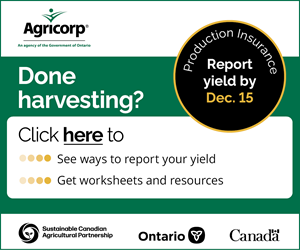Farm it like you own it
INVESTING IN RENTED LAND
HOW IS THE rising price of land and increasing farmland rental rates impacting farm management and production practices? A recent University of Guelph study asked that question, comparing farm and production practices on owned and rented land. This study builds on a longstanding research area by Dr. Brady Deaton, University of Guelph professor and McCain Family chair in food security. The recent study was conducted by Deaton in collaboration with Dr. Chad Lawley from University of Manitoba and Ph.D. student, Karthik Nadella. The research was driven by concerns about land use issues on a global and provincial scale — the implications of the increasing farmland rental trend on sustainable farming practices and overall environmental health.

“Farmland rental has been on the rise since the 1970s,” says Deaton. “And with such a significant amount of land being rented rather than owned, it’s important to know if farmers treat rented land any different than if they owned it. And what long-term impacts our farming practices have on rented land.”
According to Deaton’s research, 35 per cent of Ontario’s farmland, or four million acres, is currently on the rental market and he expects to see those numbers continue to rise. Deaton notes U.S. growers are seeing similar trends, with increasing farmland rental rates.
Deaton and his research team have been examining farmland practices and issues associated with land rental since 2011. Three surveys conducted in southern Ontario over five years compared how farmland ownership versus renting land influenced production practices and field inputs. The research found that ownership wasn’t the key driver in farmland practices or investment inputs, rather, the length of rental agreement was the biggest driver in influencing management decisions.
“The results showed that the longer a farmer expects to rent the land, the better they will treat it. Length of land use equals level of investment,” says Deaton, explaining the surveys showed that rented land didn’t receive the same level of investment in inputs as land owned by the farmer. “We now know that if a renter has a long term agreement or has farmed the property for more than five years, the land is treated with the same level of investment as ownership.”
KNOW YOUR LANDLORD
Deaton also says the study found that who the landlord is may also matter. “Tentative results suggest that farmers renting from non-farmer landlords may be less likely to plant cover crops even in the long term.”
For the purpose of the study, Deaton asked participants about investment in farmland inputs — including cover crops and sustainable farming practices like crop rotation and conservation tillage.
“The exception to the results was conservation tillage,” says Deaton. “If growers have invested in conservation, or reduced tillage equipment, they were just as likely to use it on their own land or rented land. After all, the equipment moves from field to field.”
The study also provided insight about land rental trends. Deaton explains that he’s found land rental to be financially beneficial to both renters and rental owners.
“Many farmers have found it useful to own and rent at the same time while growing their business and getting up to scale. The result is the ability to diversify their wealth portfolio, or not putting all their eggs in one basket,” says Deaton, noting many of the rental owners are non-active farm family members.
The significance of these study results could be huge when looking at the impact land rental practices have on the health and long-term sustainability of the rented property and farmland across the province. “Land use impacts soil health and the environment around the entire property,” says Deaton. “Production practices and soil health are an important consideration and is clearly part of how growers make long-term management decisions.” •






















